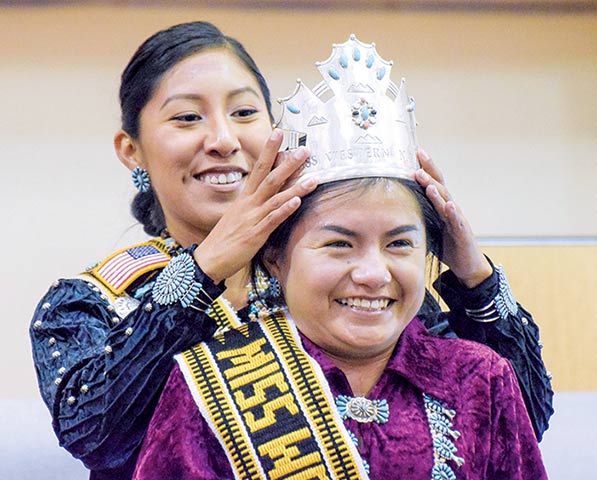
Diné bizaad wins crown for new Miss Western

Navajo Times | Krista Allen Former Miss Western Navajo Jacquelyn Johnson places the E’e’aahjígo Diné Bich’eekį crown on Rainee Style, 24, from Tónaneesdizí. Speaking Diné bizaad was what won her the title.
CAMERON, Ariz.
When her cousin-brother made Rainee Style cry, she would run home to tell her grandmother that he is terribly unkind.
“Ashkii ‘ayóo bee ádíláah!” Style would tell her grandmother, Betty Style, in tears. “I’d cry and cry, then what do I do? I get up and run back over there.”
Rainee Style was crowned the new Miss Western Navajo Saturday at Dził Łibéí Elementary School, where this year’s pageant took place.
Style was one of only two contestants. The other contestant was Sydney Tsinigine from Bodaway-Gap, Arizona.
But the Miss Western Navajo competition is not something Style thought she would win.
“At first I thought it was just going to be something that I could do for fun,” Style explained in an interview with the Navajo Times. “I thought, Why not fill out an application and see what happens? So I filled out an application. I didn’t expect to win.”
During the crowning ceremony, the 24-year-old’s brown eyes filled with tears when Tsinigine was announced as first runner-up.
With tears rolling down her cheeks and “butterflies” in her stomach, Style was named the new ‘E’e’aahjígo Diné Bich’eekį’.
“I was tired sitting up there,” Style admitted. “Now, I’m fully awake, surprised and in shock.”
It was speaking Diné bizaad that won her the Miss Western crown, said Arizona Sen. Jamescita Peshlakai, who was one of the judges for the pageant.
“The number one thing that stood out was language,” Peshlakai, who is from this community, said about Style. “It’s very apparent. That is our identity and who we are. And when it came down to it, it was very apparent that it was the language.
“It’s apparent that (Style) has the fundamental grasp of language that will catapult her into good leadership,” she continued.
“She has the desire there. You can tell she’s passionate about things, which I appreciated.”
Style says not many 20-somethings speak Navajo.
“Some of us do, but we hide it,” Style confessed. “We’re afraid that speaking Navajo in public or in a classroom is something to be ashamed of.”
But it is not something to be ashamed of, said Style, who has been speaking Diné bizaad since she was three years old, owing to her grandmother’s teaching.
“Around my age group, it’s kind of common and also kind of not, depending on whom you were brought up by, whom you were raised by,” Style said. “If Navajo is spoken in the home, children have a better chance of speaking Navajo.”
To read the full article, pick up your copy of the Navajo Times at your nearest newsstand Thursday mornings!
Are you a digital subscriber? Read the most recent three weeks of stories by logging in to your online account.








 Highway 264,
Highway 264, I-40, WB @ Winslow
I-40, WB @ Winslow